Take, shape and create
View Sequence overviewStudents will:
- demonstrate curiosity and ask questions about familiar objects and how they might be changed.
- identify ways that materials can be physically changed.
Students will represent their understanding as they:
- contribute to discussions and a class mind-map/retrieval chart on ways to physically change materials.
In the Launch phase, assessment is diagnostic.
Take note of:
- What understanding do students have of the term ‘materials’? Have they used it in its everyday sense meaning textiles? Have they begun to use it in a scientific sense?
- What understanding have students shown of physical changes? Have they named actions that can lead to physical change? Have they been able to enact these?
Whole class
Class science journal (digital or hard-copy)
A4 piece of paper
Large selection of everyday items made of different materials such as plastic, fabric/fibres, metal, wood, etc. See Preparing for this sequence for further guidance in selecting these items.
- If you elect to do the Building towers activity in this lesson, you will need a subset of everyday items for students to use to build towers.
- These materials should need to be physically changed to help them stay upright/together, e.g. through bending, folding, twisting etc. Providing ‘block’ type items that can be stacked might make a tall tower, but it does not allow students to explore how materials might be changed.
- You might provide one specific material only, such as paper and related products, or you might provide a different category of materials to different teams.
A gallery of images of different sculptures made from recycled/reused materials (see Example sculpture gallery)
Optional: Labelled buckets/containers to collect and store resources used during the unit that are made of different materials, for example wood, plastic, fabric/fibres, metal etc. At the end of each investigation, students return the items they have used to its container. This reinforces the ideas that, although the items might have been physically changed, materially it is still the same.
Each group
A4 piece/s of paper (if allowing students to test their ideas for making a paper loop)
A variety of familiar objects with which to build a tower (if undertaking this activity)
Each student
Individual science journal (digital or hard-copy)
Safety note
Special care should be taken with any items made of glass or metal. Whilst students might be able to examine and discuss these objects, supervised if required, they should be discouraged from physically changing them. Physically changing glass or metal can produce shards and sharp cutting edges that pose a danger to students.
Lesson
The Launch phase is designed to increase the science capital in a classroom by asking questions that elicit and explore students’ experiences. It uses local and global contexts and real-world phenomena that inspire students to recognise and explore the science behind objects, events and phenomena that occur in the material world. It encourages students to ask questions, investigate concepts, and engage with the Core Concepts that anchor each unit.
The Launch phase is divided into four routines that:
- ensure students experience the science for themselves and empathise with people who experience the problems science seeks to solve (Experience and empathise)
- anchor the teaching sequence with the key ideas and core science concepts (Anchor)
- elicit students’ prior understanding (Elicit)
- and connect with the students’ lives, languages and interests (Connect).
Students arrive in the classroom with a variety of scientific experiences. This routine provides an opportunity to plan for a common shared experience for all students. The Experience may involve games, role-play, local excursions or yarning with people in the local community. This routine can involve a chance to Empathise with the people who experience the problems science seeks to solve.
When designing a teaching sequence, consider what experiences will be relevant to your students. Is there a location for an excursion, or people to talk to as part of an incursion? Are there local people in the community who might be able to talk about what they are doing? How could you set up your classroom to broaden the students’ thinking about the core science ideas? How could you provide a common experience that will provide a talking point throughout the sequence?
Read more about using the LIA FrameworkPaper loops and building towers
The following tasks are two options for how you might support students to have a shared experience to begin this teaching sequence. Paper loops relates to the content of the unit (how materials can be changed) and Building towers relates to the context of the unit (how we might build a 3D sculpture or model using materials that have been physically changed).
Select the task that best suits the needs and context of your students and classroom. You may choose to do both if time permits.
Paper loops
Students work in collaborative teams on the following challenge: How might we change an A4 piece of paper in a way that would allow us to easily step through it?
Allow students time to brainstorm, and if appropriate, test their ideas.
Share students’ ideas as a class.
Demonstrate how a piece of A4 paper can be cut to form a loop large enough for students to step through carefully:
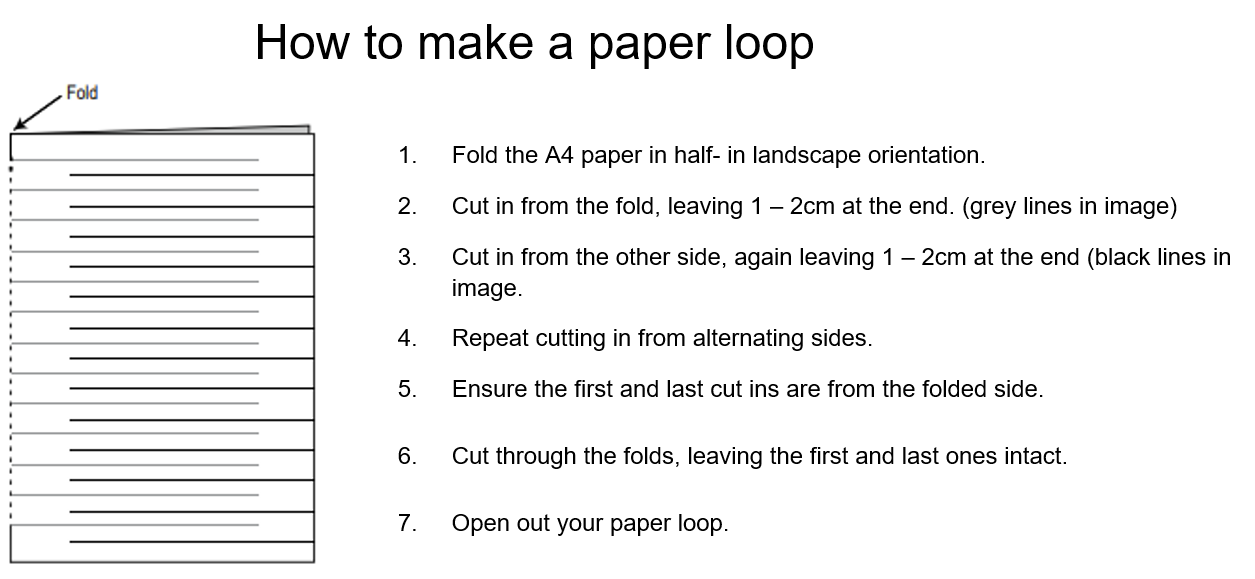
Discuss how the paper has changed, and also how it has not changed.
- What has changed?
- The shape of the paper.
- How was it changed?
- It was cut with scissors.
- What else might you use besides scissors?
- Do you think you could do the same thing with larger piece of paper? A smaller piece?
- What has not changed about the paper?
- Colour, weight, what it’s made of.
- What do we know about paper? What is it made of? How it can be changed?
- It can be torn, cut, folded, rolled, bent, twisted, scrunched etc.
- What is it used for?
Optional: Allow students the opportunity to make their own paper loops.
Building towers
Provide students in collaborative teams with an assortment of everyday items and issue the challenge: Build the tallest tower possible with your objects. Ask them to take note of what they do to each object to make it stay in place.
Allow teams time to build their towers, then view each team’s tower before discussing what students did.
- What objects have you used to build your tower?
- What materials are these objects made of?
- It is important to distinguish between the name of the object and the material it is made out of.
- In some cases the object and material might be the same (a piece of paper is made of paper), but students might also answer that they have made their tower out of yogurt containers, for example, which are made of plastic.
- How have you made your tower stay together? Did you fold things, twist them, squash or squish them?
Adapting to your context
Adapt this lesson to the needs of your students and context.

The Paper loops task focuses on the sequence's science understanding content: physically changing materials. It may be appropriate to select this task if you have limited access to resources.
The Building towers task focuses on the sequence's context: building a sculpture or model out of repurposed materials that have been physically changed. It may be appropriate to select this task if your students require an experience of building a model or sculpture.
You might also choose to undertake both tasks.
The Paper loops task focuses on the sequence's science understanding content: physically changing materials. It may be appropriate to select this task if you have limited access to resources.
The Building towers task focuses on the sequence's context: building a sculpture or model out of repurposed materials that have been physically changed. It may be appropriate to select this task if your students require an experience of building a model or sculpture.
You might also choose to undertake both tasks.
Core concepts and key ideas
When planning for teaching in your classroom, it can be useful to see where a sequence fits into the larger picture of science.
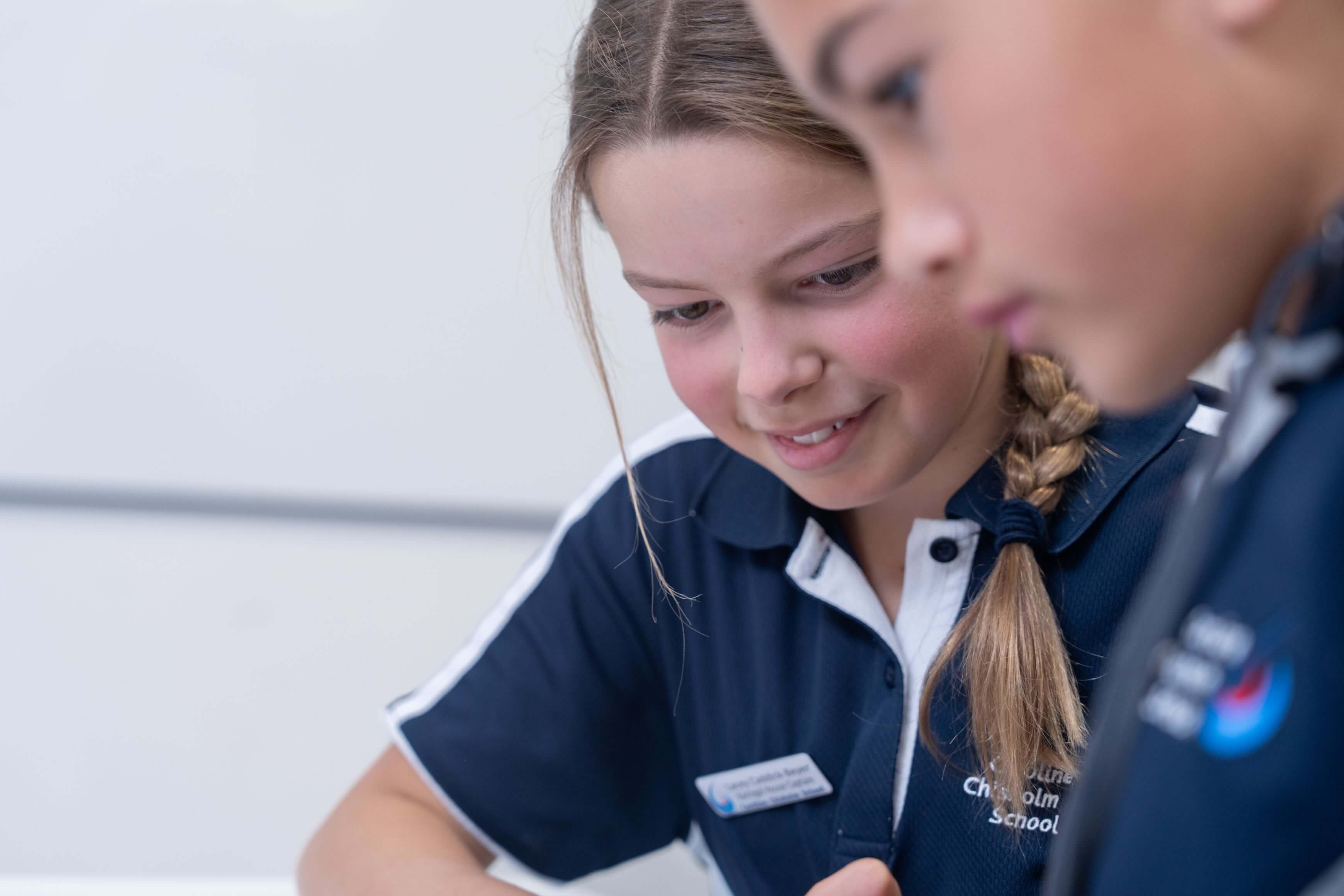
When planning for teaching in your classroom, it can be useful to see where a sequence fits into the larger picture of science. This unit is anchored to the Science understanding core concepts for Chemical sciences.
- Substances change and new substances are produced by rearranging atoms; these changes involve energy transfer and transformation.
In Year 2, this involves recognising that materials can be changed physically without changing their material composition and exploring the effect of different actions on materials including bending, twisting, stretching, and breaking into smaller pieces.
This core concept is linked to the key science ideas:
- objects and living things have observable characteristics. (Form and function)
- objects and events can be sorted based on observed characteristics. (Patterns, order, and organisation)
- parts and processes can be named. (Systems)
- relative language can be used to compare objects and phenomena and describe change (bigger/smaller, faster/slower, louder/softer). (Scale and measurement)
When your students next progress through this core concept, they will investigate the observable properties of solids and liquids and how adding or removing heat energy leads to a change of state (Year 3).
When planning for teaching in your classroom, it can be useful to see where a sequence fits into the larger picture of science. This unit is anchored to the Science understanding core concepts for Chemical sciences.
- Substances change and new substances are produced by rearranging atoms; these changes involve energy transfer and transformation.
In Year 2, this involves recognising that materials can be changed physically without changing their material composition and exploring the effect of different actions on materials including bending, twisting, stretching, and breaking into smaller pieces.
This core concept is linked to the key science ideas:
- objects and living things have observable characteristics. (Form and function)
- objects and events can be sorted based on observed characteristics. (Patterns, order, and organisation)
- parts and processes can be named. (Systems)
- relative language can be used to compare objects and phenomena and describe change (bigger/smaller, faster/slower, louder/softer). (Scale and measurement)
When your students next progress through this core concept, they will investigate the observable properties of solids and liquids and how adding or removing heat energy leads to a change of state (Year 3).
The Launch phase is designed to increase the science capital in a classroom by asking questions that elicit and explore students’ experiences. It uses local and global contexts and real-world phenomena that inspire students to recognise and explore the science behind objects, events and phenomena that occur in the material world. It encourages students to ask questions, investigate concepts, and engage with the Core Concepts that anchor each unit.
The Launch phase is divided into four routines that:
- ensure students experience the science for themselves and empathise with people who experience the problems science seeks to solve (Experience and empathise)
- anchor the teaching sequence with the key ideas and core science concepts (Anchor)
- elicit students’ prior understanding (Elicit)
- and connect with the students’ lives, languages and interests (Connect).
The Elicit routine provides opportunities to identify students’ prior experiences, existing science capital and potential alternative conceptions related to the Core concepts. The diagnostic assessment allows teachers to support their students to build connections between what they already know and the teaching and learning that occurs during the Inquire cycle.
When designing a teaching sequence, consider when and where students may have been exposed to the core concepts and key ideas in the past. Imagine how a situation would have looked without any prior knowledge. What ideas and thoughts might students have used to explain the situation or phenomenon? What alternative conceptions might your students hold? How will you identify these?
The Deep connected learning in the ‘Pedagogical Toolbox: Deep connected learning’ provides a set of tools to identify common alternative conceptions to aid teachers during this routine.
Read more about using the LIA FrameworkExamining objects
Provide a large selection of everyday items for students to examine. Individually or with a partner, students examine and discuss an object, sharing their prior knowledge about it and discussing ways it could be physically changed. Model a sample discussion for students.
- What is it?
- What is it made of?
- What is it used for?
- Is there a similar item to it made of something different e.g. plastic and metal spoons?
- What could you do to this item to change its size, shape, thickness, length, etc.?
Some examples of physically changing objects that you might wish to draw out through discussion are: bending, twisting, folding, scrunching, stretching, cutting, tearing, chopping, breaking, heating, cooling, sanding/filing.
Allow students time to examine and discuss their objects.
Share students’ ideas and collect the information in a table in the class science journal. For example:
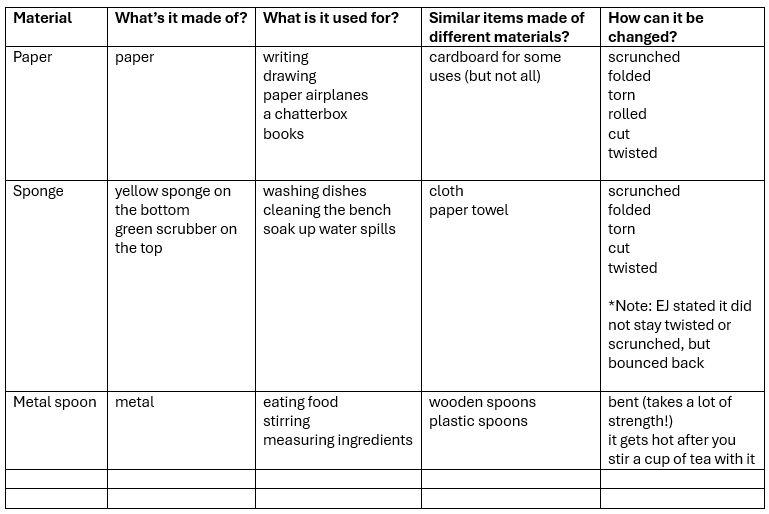
Further discuss the objects.
- What couldn’t you do to change this object?
- For example, you couldn’t rip a piece of metal.
- What change might make this object a safety hazard?
- You could crush a glass bottle, but doing that would make it sharp, and you could cut yourself.
- What actions do we make when we twist, bend, fold, scrunch etc. a material? How are these actions similar and different?
- Encourage students to use physical actions to show how they twist, fold, or scrunch something.
- Can we use a different amount of strength/ level of force when we make these actions? How do you think that will affect what happens?
Questioning
These eliciting and probing questions have been designed to draw out students’ prior knowledge.
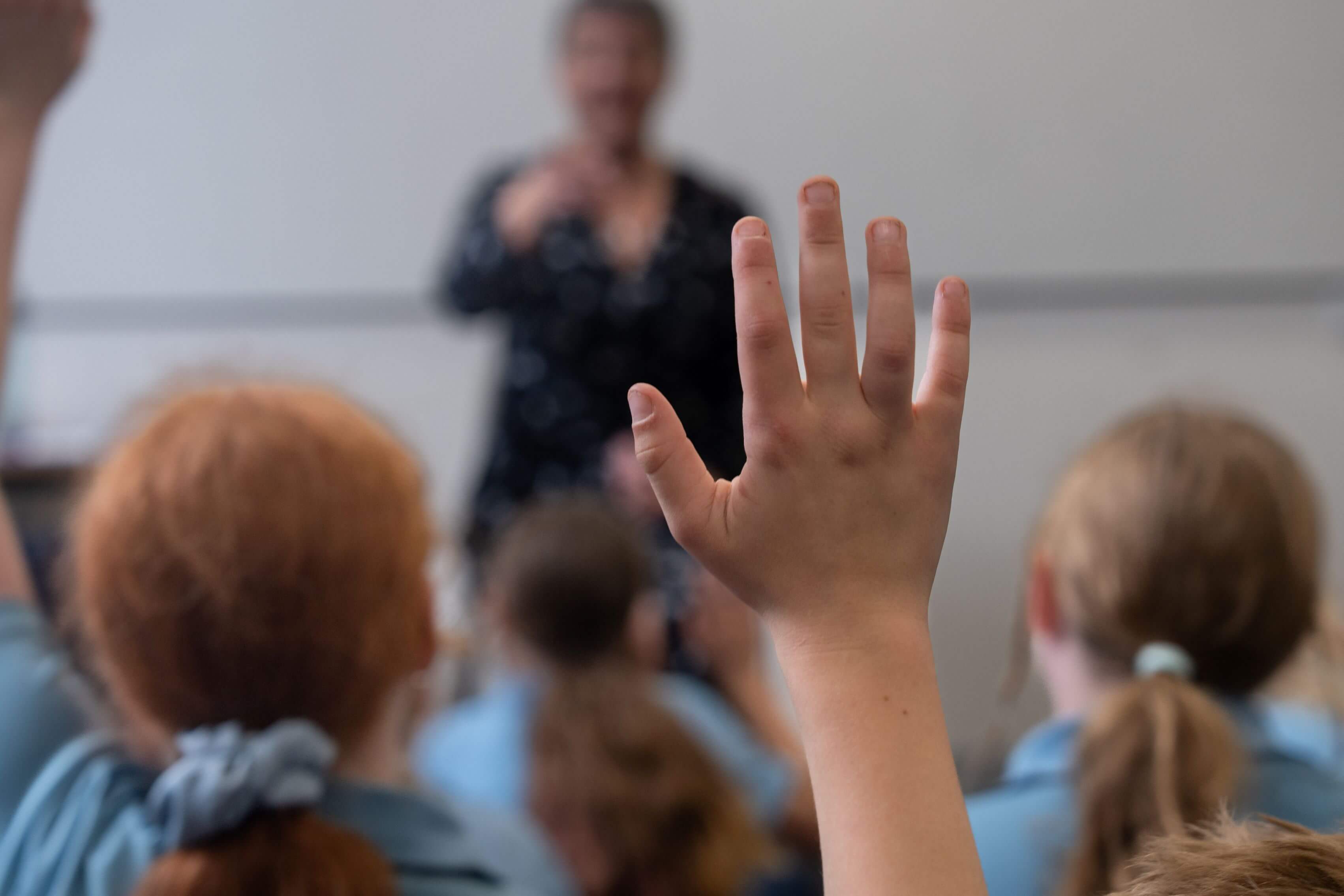
These eliciting and probing questions have been designed to draw out students’ prior knowledge of everyday materials and how they might be changed.
By describing the actions that cause physical changes (for example, to twist something we usually hold either end and turn our hands in opposite directions, to stretch something, we hold both ends and pull in opposite directions), and how using different amounts of force can impact these changes, students will be better equipped to represent the physical changes as the sequence progresses. It also implicitly connects to the physically sciences by referring to the force required to make physical changes. These links do not need to be made explicit at this stage.
These eliciting and probing questions have been designed to draw out students’ prior knowledge of everyday materials and how they might be changed.
By describing the actions that cause physical changes (for example, to twist something we usually hold either end and turn our hands in opposite directions, to stretch something, we hold both ends and pull in opposite directions), and how using different amounts of force can impact these changes, students will be better equipped to represent the physical changes as the sequence progresses. It also implicitly connects to the physically sciences by referring to the force required to make physical changes. These links do not need to be made explicit at this stage.
The Launch phase is designed to increase the science capital in a classroom by asking questions that elicit and explore students’ experiences. It uses local and global contexts and real-world phenomena that inspire students to recognise and explore the science behind objects, events and phenomena that occur in the material world. It encourages students to ask questions, investigate concepts, and engage with the Core Concepts that anchor each unit.
The Launch phase is divided into four routines that:
- ensure students experience the science for themselves and empathise with people who experience the problems science seeks to solve (Experience and empathise)
- anchor the teaching sequence with the key ideas and core science concepts (Anchor)
- elicit students’ prior understanding (Elicit)
- and connect with the students’ lives, languages and interests (Connect).
Science education consists of a series of key ideas and core concepts that can explain objects, events and phenomena, and link them to the experiences encountered by students in their lives. The purpose of the Anchor routine is to identify the key ideas and concepts in a way that builds and deepens students’ understanding. During the Launch phase, the Anchor routine provides a lens through which to view the classroom context, and a way to frame the key knowledge and skills students will be learning.
When designing a teaching sequence, consider the core concepts and key ideas that are relevant. Break these into small bite-sized pieces that are relevant to the age and stage of your students. Consider possible alternative concepts that students might hold. How could you provide activities or ask questions that will allow students to consider what they know?
Sculpture gallery
Explain that now students have seen and discussed how familiar objects and materials can be changed, they will examine ways in which artists have used and changed everyday, familiar objects to create sculptures/models.
Display an image gallery of sculptures made with clearly identifiable recycled and reused objects/materials.
Discuss: What is a sculpture? Why do people make them? Think about any sculptures in the school environment and what their purpose is.
Discuss and define the term ‘object’ and ‘material’, noting the difference between everyday use of ‘material’ and its scientific use. Note that objects are made up of a single material or a combination of different materials.
Discuss the objects/materials used in the sculptures you have displayed, and how the materials have been physically changed to create each sculpture.
Note: Both the terms ‘object’ and ‘material’ have been used here. That is because students might refer to either when describing the sculptures. If they name an object, probe further to see if they can also name the material/s that object is made of.
- What objects/materials can you see?
- What materials have the objects been made from?
- What do you think they objects were originally used for used for? What do they all have in common?
- Why do you think the objects have been made out of these materials?
- How have these objects/materials been changed?
- What techniques have been used to change them?
- How have they stayed the same?
- What might we have to think about when we design and create our own sculptures?
Materials
Students might associate the word ‘material’ with textiles, fabric, clothes or cloth.
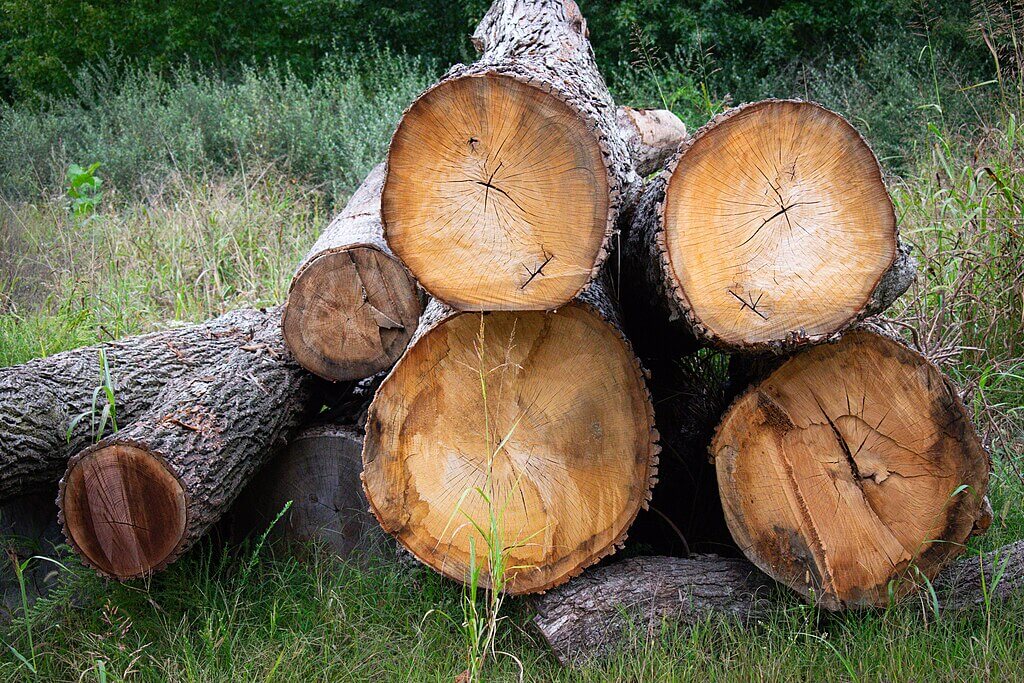
Students might associate the word ‘material’ with textiles, fabric, clothes or cloth. This is a valid everyday use of the word ‘material’. However, scientifically speaking, ‘materials’ refers to the matter or substance that makes up an object. Materials can be natural/pure (e.g. wood, wool) or man-made/impure (e.g. steel, plastic). Materials are classified on the basis of their physical and chemical properties, geological origin or biological function.
Materials can be changed physically or chemically.
Physical changes alter the shape, form etc. of a material, but the atomic structure of the material remains the same. Physical changes are considered reversible. For example, paper can be cut, torn, twisted and folded into many different sizes and shapes. Ultimately it is still paper and it could be pulped and reformed into another paper product. This understanding is the focus for this teaching sequence.
Chemical changes occur when the original substances are consumed, and a new substance is created. Chemical changes are considered irreversible. For example, when baking a cake, the different ingredients are mixed together to create a batter. Once heated this batter forms a new substance: cake. This process cannot be reversed to separate the individual ingredients again.
Students might associate the word ‘material’ with textiles, fabric, clothes or cloth. This is a valid everyday use of the word ‘material’. However, scientifically speaking, ‘materials’ refers to the matter or substance that makes up an object. Materials can be natural/pure (e.g. wood, wool) or man-made/impure (e.g. steel, plastic). Materials are classified on the basis of their physical and chemical properties, geological origin or biological function.
Materials can be changed physically or chemically.
Physical changes alter the shape, form etc. of a material, but the atomic structure of the material remains the same. Physical changes are considered reversible. For example, paper can be cut, torn, twisted and folded into many different sizes and shapes. Ultimately it is still paper and it could be pulped and reformed into another paper product. This understanding is the focus for this teaching sequence.
Chemical changes occur when the original substances are consumed, and a new substance is created. Chemical changes are considered irreversible. For example, when baking a cake, the different ingredients are mixed together to create a batter. Once heated this batter forms a new substance: cake. This process cannot be reversed to separate the individual ingredients again.
The Launch phase is designed to increase the science capital in a classroom by asking questions that elicit and explore students’ experiences. It uses local and global contexts and real-world phenomena that inspire students to recognise and explore the science behind objects, events and phenomena that occur in the material world. It encourages students to ask questions, investigate concepts, and engage with the Core Concepts that anchor each unit.
The Launch phase is divided into four routines that:
- ensure students experience the science for themselves and empathise with people who experience the problems science seeks to solve (Experience and empathise)
- anchor the teaching sequence with the key ideas and core science concepts (Anchor)
- elicit students’ prior understanding (Elicit)
- and connect with the students’ lives, languages and interests (Connect).
Each student comes to the classroom with experiences made up from science-related knowledge, attitudes, experiences and resources in their life. The Connect routine is designed to tap into these experiences and that of their wider community. It is also an opportunity to yarn with community leaders (where appropriate) to gain an understanding of the student’s lives, languages and interests. In the Launch phase, this routine identifies and uses the science capital of students as the foundation of the teaching sequence so students can appreciate the relevance of their learning and its potential impact on future decisions. In short, this routine moves beyond scientific literacy and increases the science capital in the classroom and science identity of the students.
When planning a teaching sequence, take an interest in the lives of your students. What are their hobbies, how do they travel to and from school? What might have happened in the lives of your students (i.e. blackouts) that might be relevant to your next teaching sequence? What context might be of interest to your students?
Read more about using the LIA FrameworkHow can we use our learning?
Introduce and link the context and content of the teaching sequence: students will be learning about the effects of using different methods to change a material’s size, shape, thickness, texture. They will then apply these ideas to make a 3D sculpture/model that utilises the materials we see and use everyday in a new way. If you have selected a specific theme for the sculpture that will govern its design (see Preparing for this sequence), introduce this theme here also.
You might like to share sculptures during a class or school event, such as an ‘art show’. Inform students of the selected mode of showing their sculptures/models.
Support students to generate any questions they have about materials and how they might be physically changed, what affect these changes might have on the material, and what that might mean for the sculpture they design.
Record student questions to refer back to during the course of the unit.
Reflect on the lesson
You might:
- group together similar questions and ask students which ones they think would be important to answer first.
- begin a class word wall related to materials and how they can be changed.
Student-generated questions
The investigations in this sequence are drawn from student questions and discussions.
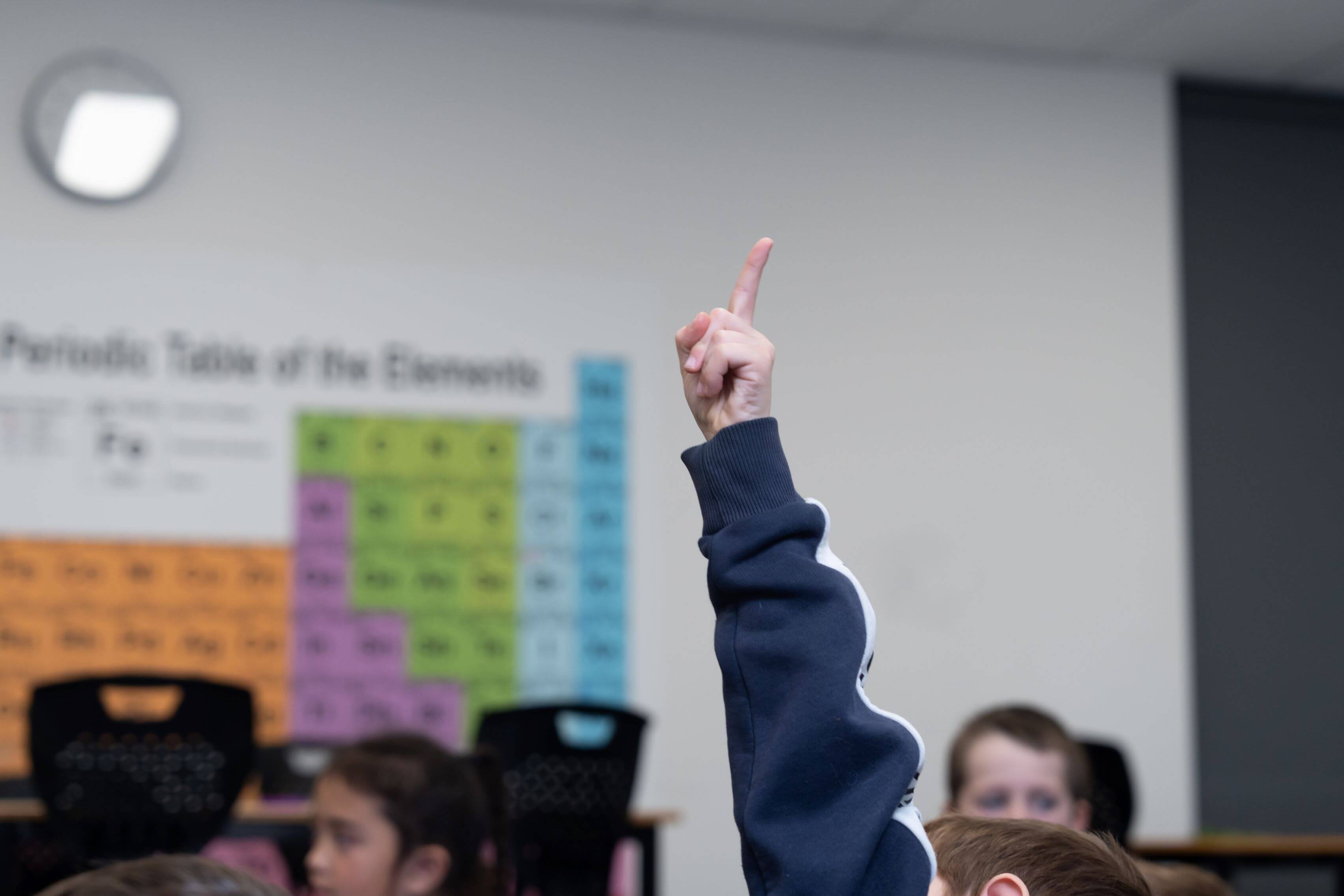
Refer to the sequence overview and note the questions that the investigations in this learning sequence will address. You might decide to use questioning and discussion techniques to ensure these questions (or similar) are drawn out during the discussion.
At the end of each lesson/cycle during the Inquire phase, students will have an opportunity to ask more questions as a result of what they have experienced. This is also an opportunity to ensure that the necessary questions are added to the list.
You might also consider planning an investigation for relevant questions that are not addressed by this unit.
Refer to the sequence overview and note the questions that the investigations in this learning sequence will address. You might decide to use questioning and discussion techniques to ensure these questions (or similar) are drawn out during the discussion.
At the end of each lesson/cycle during the Inquire phase, students will have an opportunity to ask more questions as a result of what they have experienced. This is also an opportunity to ensure that the necessary questions are added to the list.
You might also consider planning an investigation for relevant questions that are not addressed by this unit.